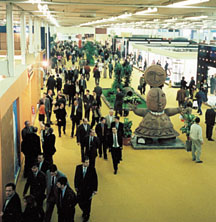Cevisama 2001: Uncovering a New Interest in the U.S. Tile Market


This year, companies representing more than 40 countries displayed the latest technologies, designs and accessories for the ceramic and stone industry. Nearly 120 Italian firms made the journey to Valencia, as did 45 companies from Portugal. Thirteen U.S.-based exhibitors completed the trans-Atlantic trip as well.
Spanish companies exported nearly $1.4 billion of tile during the first 10 months of 2000, according to ICEX, the Spanish Institute of Foreign Trade. The United States continues to be Spain's No. 1 customer, with purchases for that period totaling more than $175 million.
Sales to the United States grew by nearly 25% during 2000, the second largest annual increase in any market save Saudi Arabia, where imports rose by almost 40%. Ceramic tile exports to the United States have more than doubled since 1996, when sales amounted to just under $84 million.

The company is responsible for 17% of all Spanish floor tile sold in the United States, according to Luaces. Gres de Valls deals solely in the residential marketplace, with nearly 45% of its product sales ending up in new-home construction.
Fifteen percent of Roca Ceramica's exports end up on U.S. soil. The company uses both traditional ceramic dealers and floor covering dealers to sell its products, with the majority of floor covering dealers being utilized in the western and southern regions of the country.
A number of companies rolled out new products at their booths in Valencia that will also be making the trip to New Orleans for Coverings 2001, May 21-23. Ceramica Penarroya's Sicilia will be found at the company's booth in the Morial Convention Center, as will the Piscis collection from Colorker, Cristal's Marta collection, and Super Ceramica's Daka and Mercuri collections, featuring Kerajet and Quickpaint technologies from Ferro.

Ecology is the latest offering from Tres Estilos, the company known for receiving the prestigious Alfa de Oro award in three of the last four years. Ecology incorporates colored clays with natural oxides which, when kilned at very high temperatures, turn the obtained porcelanic material totally inert, making the end product environmentally sound, the company says.
Porcelain is developing a larger presence in the tile market. The Lancelot Collection from Inalco will be available to Coverings attendees. Diago Ceramicas is introducing a new porcelain line to the Diago Gallery Collection, incorporating the company's Ligeramica production system, a winner of the 2000 Alfa de Oro award. Halcon is expected to be unveiling an as-yet-unnamed white-body porcelain tile at Coverings, while Tau Ceramica's porcelain, slate-look Toscano series makes quite an impact.
A truly unique product worthy of a look is Plak'up, co-developed by Tau and Esmalglass, a Spanish glaze company. Plak'up is a 100% glaze product, pressed and polished, that weighs almost one-third less than a ceramic tile of comparable size. Azuvi, meanwhile, is introducing Porcelanic Glass, a new construction process for tile that incorporates the characteristics of glazed porcelain tile with right-out-of-the-box installation ease.
The renewed interest in the U.S. market is leading many companies to revisit their strategies for sales and marketing. Porcelanatto Cerfogres currently has a warehouse in New Jersey, with plans for another in California. Why develop a new location? The company's first goal is to make its products readily available, then go after the retailers.
"We are increasing our emphasis on service to the client," explains Porcelannato Director of Export Fernando Gil. "Our approach is one of don't say 'no' to anything, but instead find a way to work with our customers."
Keraben's methodology for entry into the U.S. market is the same as for any other. "We research the market - talk with agents, customers, everyone - before going into production on any new line or design for that market," said Keraben Director General Rafael Estrems.
The warehouse and office in Miami that houses Alcalagres' U.S. division allows the company to independently assess and adapt to the needs of the American consumer, while staying in sync with the home office. The company's main focus is on higher-end products, but officials say that there are near-term plans for some changes in how the company approaches the United States market.
"Our next step is to find distributors who are interested in our product lines, then possibly think about putting a warehouse on the West Coast," Managing Director Fernando Vidal said.
The advancing tastes and sophistication of the American consumer, coupled with the desire for growth by Spanish tile manufacturers, should result in one of the more exciting years of design and product rollouts of the past decade.
Looking for a reprint of this article?
From high-res PDFs to custom plaques, order your copy today!





